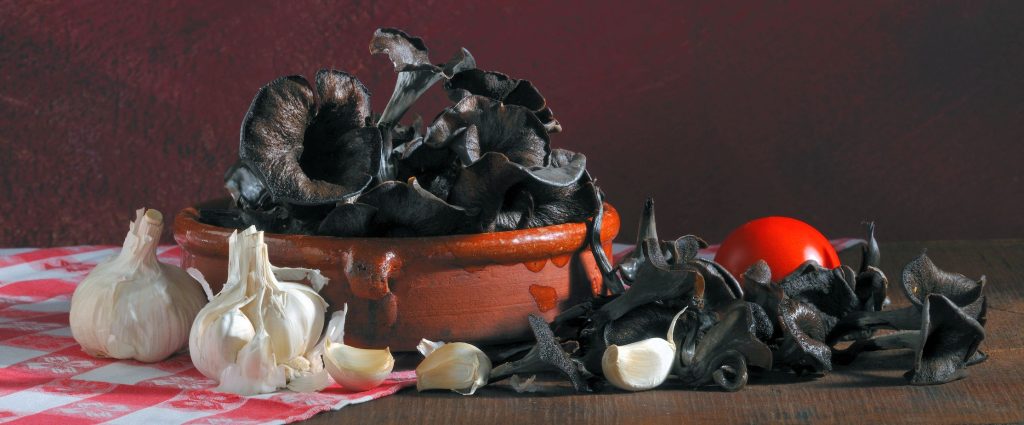Black trumpet mushrooms are some of the best tasting wild mushrooms out there. In our opinion, they’re on par with other favorites like chanterelles and morels.
Although black trumpets are difficult to find, they’re easy to identify. They don’t have any poisonous look-alikes, which makes them great for new mushroom hunters.
In this article, you’ll learn how to identify black trumpet mushrooms. By the end you’ll know where and when to look for them and how to prepare them once you find them.
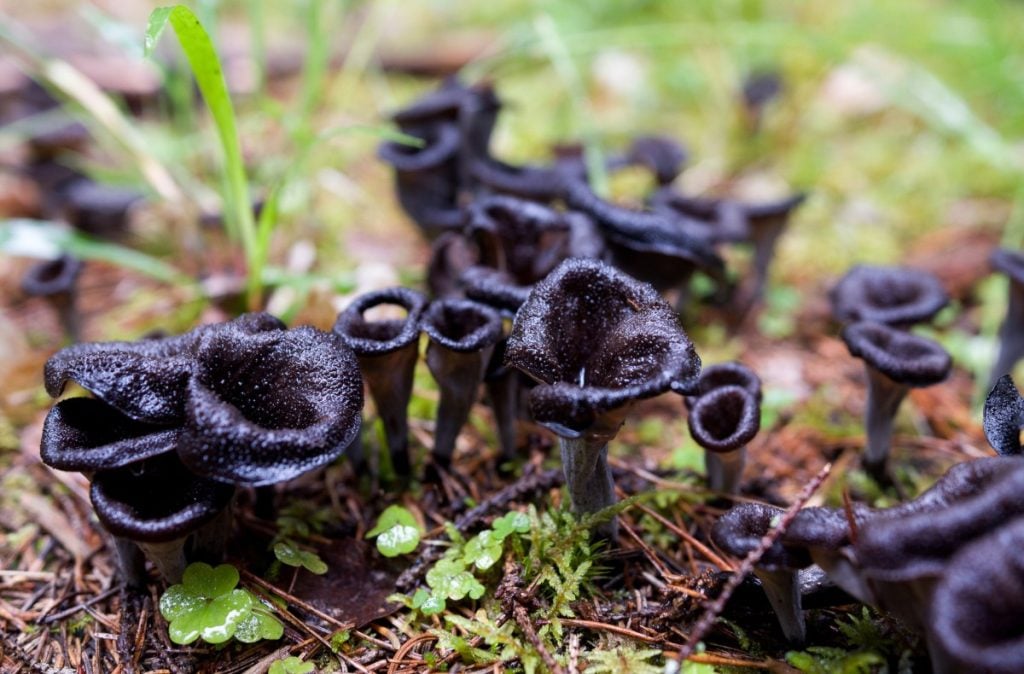
What Is a Black Trumpet Mushroom?
The black trumpet is a variety of edible wild mushrooms. Its Latin name is Craterellus cornucopioides.
It’s also known by several other names around the world.
Some people refer to it as the “horn of plenty” mushroom.
This is a reference to the cornucopia. A horn of abundance that originates from Greek mythology. According to legend, it fills itself with whatever food or drink its owner requests.
The black trumpet mushroom is called the “trumpet of the dead” across many cultures.
The French call it “la trompette de mort” and the Italians call it “trombetta dei morti.”
This name doesn’t refer to the mushroom being poisonous. Rather, people imagined that the mushrooms were trumpets played by dead people under the ground.
In Haiti, the mushroom is called djondjon.
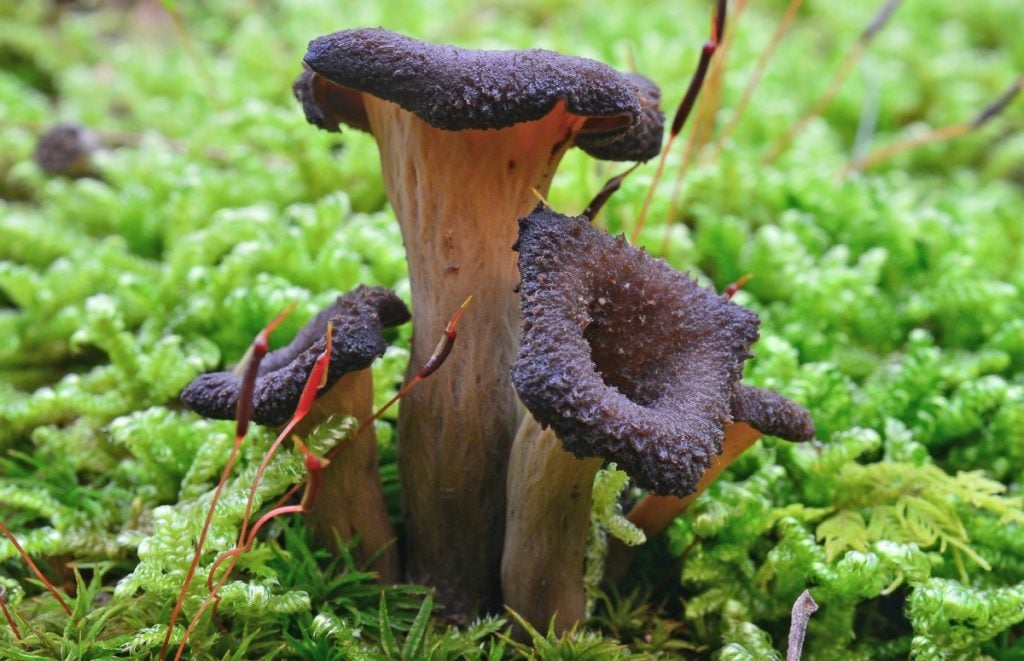
Where and When Do Black Trumpet Mushrooms Grow?
This black mushroom grows in hardwood forests. They specifically prefer growing near broad-leaved trees like beech or oak.
Although black trumpet mushrooms don’t fruit directly on living or dead wood, they do grow near it. You’ll often find black trumpet mushrooms growing right at the base of trees.
You can find black trumpet mushrooms growing in the wild in North America, Europe and Asia.
Within Europe, they’re common in some countries like the United Kingdom. Meanwhile, they’re quite rare in others like the Netherlands.
Like most mushrooms, black trumpets prefer to grow in dark and damp places.
Black trumpet mushrooms are often found in mossy areas, a good sign that lots of moisture is present.
Looking in mossy areas also makes it easier to find the mushrooms. Their black hue contrasts better against the green moss.
Against leaf litter on a forest floor, it’s more difficult to find trumpet mushrooms because of their dark color.
Trumpet mushrooms also tend to grow in areas with heavy lime or calcium content. So looking in areas near limestone deposits or with whitish soil also helps.
Lastly, looking in swampy areas, near small streams or other water sources. This will also increase your chances of finding these mushrooms.
Increase your chances of finding black trumpet mushrooms by looking down and walking slowly. You’ve got to be basically right over top of them or they’re easy to miss.
At first glance, they may look more like holes in the ground than mushrooms.
Once you find a single black trumpet mushroom, carefully examine the area. They tend to grow in clusters. So where there’s one, there might be more nearby.
Are you wondering how those mushrooms got there in the first place? Where do Mushrooms Come From? All Questions Answered explains it all.
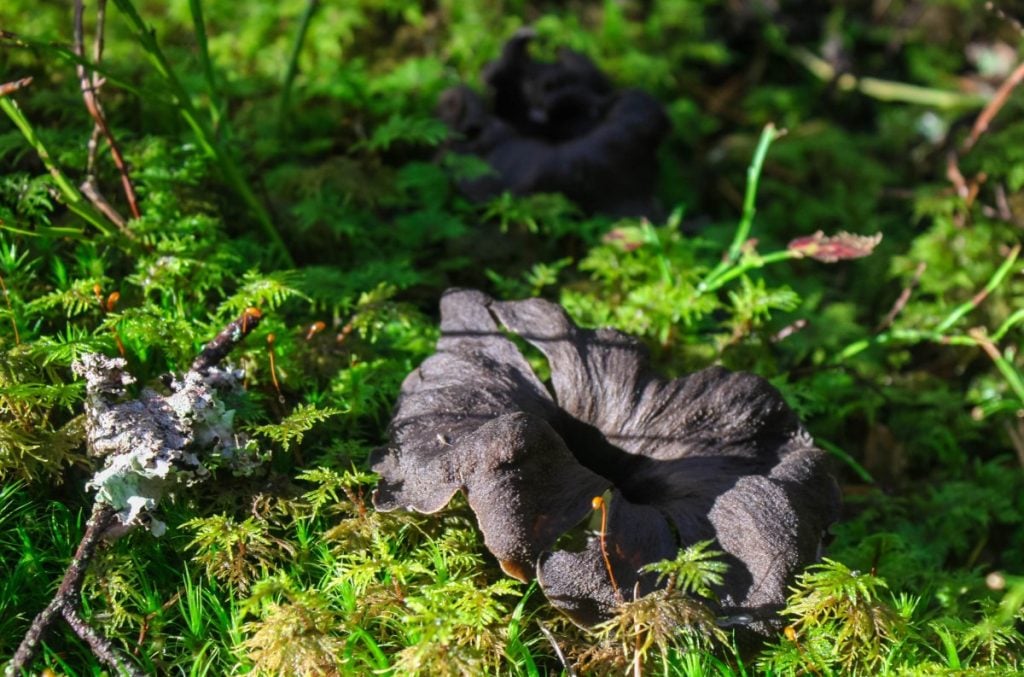
When To Look for Black Trumpet Mushrooms
In England, you can find black trumpet mushrooms in the wild between August and November.
In North America, black trumpet season depends on whether you live on the east or west coast.
West Coast black trumpet mushrooms grow in the winter. From November until the beginning of March.
East Coast black trumpet mushrooms grow in the summer. From mid-July until the end of August.
There’s some debate in the mushroom community about whether these mushrooms on the different coasts are the same species or distinct.
Some people refer to the Eastern variant as a separate species. It’s called Craterellus fallax to distinguish it from the Western variant.
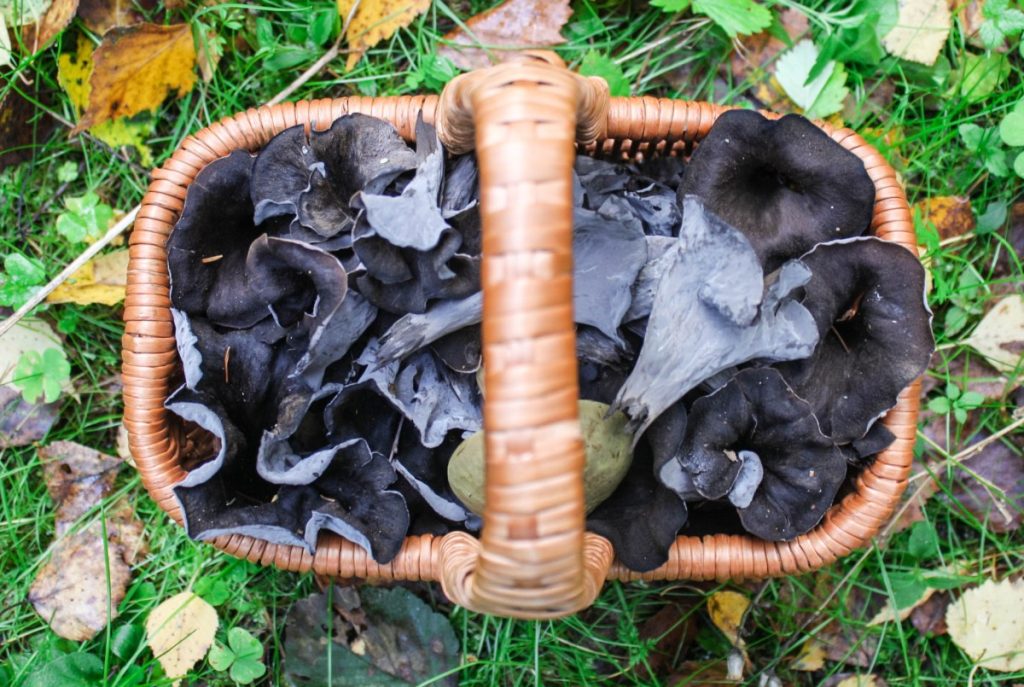
How Do Black Trumpet Mushrooms Grow?
One thing that’s interesting about black trumpet mushrooms is that they seem to be both mycorrhizal and saprotrophic.
That means they grow both around certain varieties of trees and sometimes living on decaying matter. Most mushrooms usually only operate in one way or the other.
You can often find black trumpet mushrooms in the same areas where chanterelle mushrooms grow too. So you can be looking for multiple varieties of mushrooms at the same time.
See our Complete Guide To Chanterelle Mushrooms before you head out mushroom hunting.

What Do Black Trumpet Mushrooms Look and Feel Like?
Black trumpet mushrooms are quite easy to identify.
They’re funnel shaped and their color can range from black to gray or brown.
Cap
The cap is vase-shaped with wavy edges that roll outwards.
The underside of a black trumpet mushroom cap is smooth or slightly wrinkled. It has no gills, teeth or pores.
Stem
A black trumpet mushroom’s stem can be up to 4 inches (10 centimeters) tall. The color of the stem is the same as the cap, or slightly lighter.
The stem is hollow and thin and is easily broken with your fingers.
Texture
The texture of black trumpet mushrooms is soft. They feel almost like a suede material because of their smooth surface.
Spore Print
You shouldn’t use a spore print of a black trumpet mushroom as a sole identifying factor. The color of this mushroom’s spores can range from white to pinkish.
In some places, the spore print can even be yellowish.
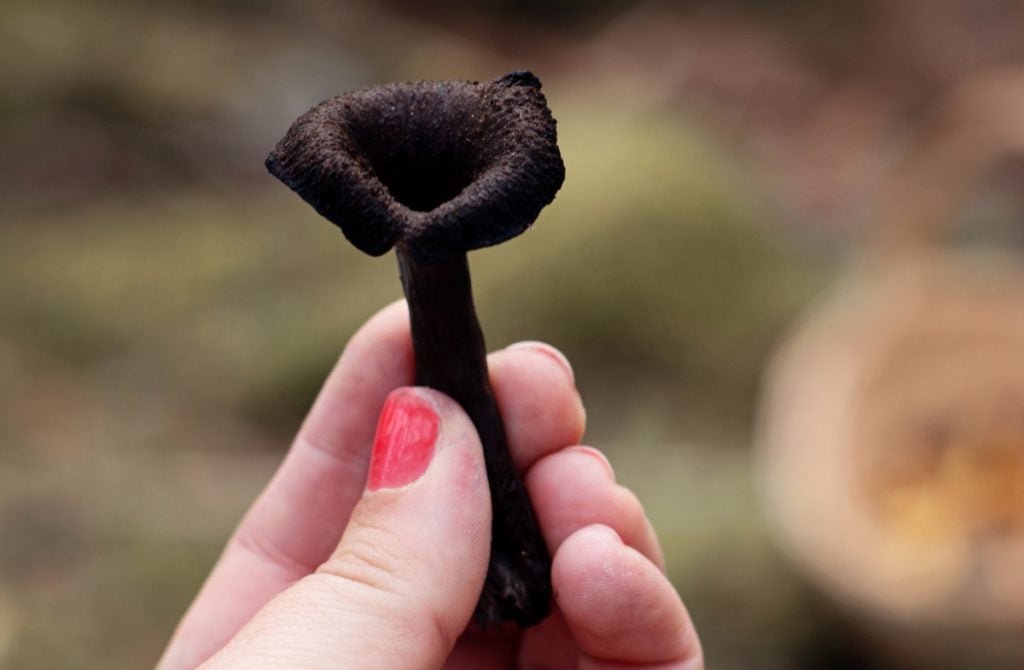
Black Trumpet Mushroom Look Alikes
You won’t find a black trumpet mushroom look alike that’s poisonous. That makes them great for beginner mushroom hunters.
The most commonly confused mushroom is the devil’s urn (Urnula craterium.) Although it isn’t poisonous, it doesn’t taste as nice as a black trumpet.
This lookalike also grows in spring, as opposed to black trumpets which grow in the summer or fall in most areas.
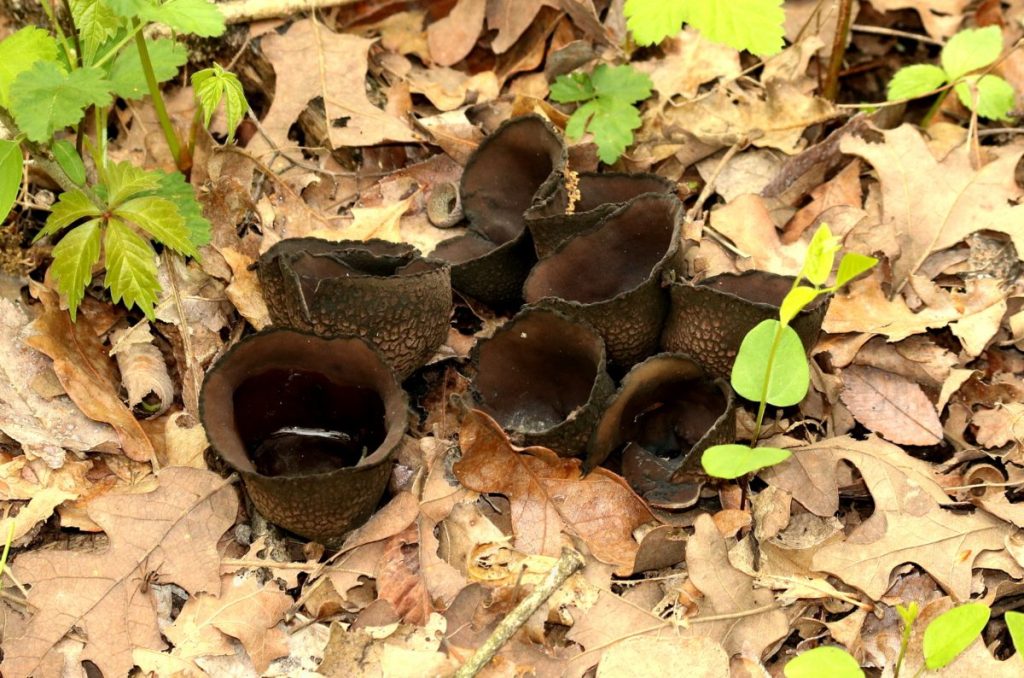
Are Black Trumpet Mushrooms Rare?
Black trumpet mushrooms aren’t especially rare. Not when compared to other wild mushroom varieties like chanterelles or porcini.
It’s just that their dark color and odd shape makes them hard to see against the forest floor. It’s easy to walk past them without noticing if you aren’t looking carefully.
You aren’t likely to stumble upon them unless you’re specifically looking for them. Because of this, some mushroom hunters may go years without finding one.
Like we mentioned earlier, stick to mossy areas to increase the mushroom’s contrast against the forest floor and make them easier to spot.
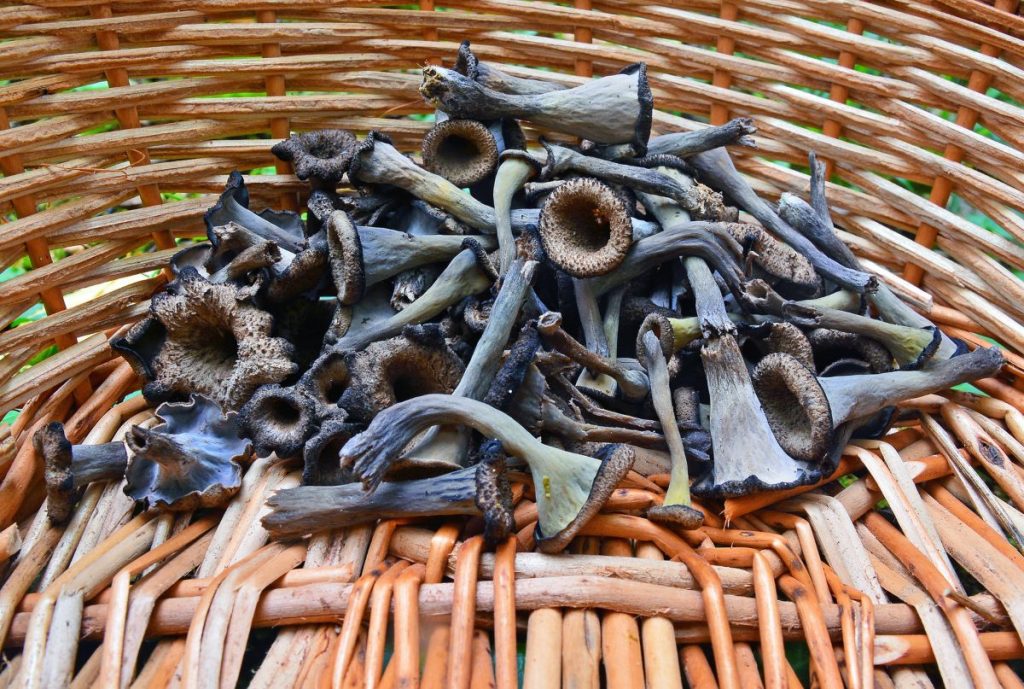
What Is Black Trumpet Mushroom Flavor?
Wondering what black trumpet mushrooms taste like?
In our humble opinion, they’re one of the best tasting wild mushrooms up there. We’d rank them right alongside other famous edible wild mushrooms like chanterelles, porcinis or morels.
Don’t let their humble appearance fool you. You might even compare their flavor as tasting similar to truffles, one of the most expensive types of fungi available.
Black truffle mushrooms have a rich, smoky flavor and a fruity aroma. In their fresh form, these mushrooms are especially potent and full of flavor.
Our only word of warning is that if you use too many black trumpets in a dish, there’s a chance they may impart a bitter flavor.
Cooking in some form of fat, such as butter, can counteract this bitterness.
How To Store Black Trumpet Mushrooms
Since black trumpet mushrooms tend to grow in patches or clusters, there’s a good chance you’ll stumble upon more than you can eat fresh. You’ll need to preserve some of them.
We’ve heard of people finding 40 pounds (18 kilograms) or more in a single spot!
Thankfully, the fact that black trumpet mushrooms are hollow makes them able to dry out fast and easily.
You can simply leave black trumpet mushrooms sitting out at room temperature in the open air and they’ll naturally dehydrate.
If they’re especially damp, you can put them in a food dehydrator or an oven on the lowest setting for a couple of hours to pull out the extra moisture first.
You can tell your black trumpet mushrooms are dry enough to store when they’re brittle and break easily, similar to a cracker.
At that point, you can simply seal them in a mason jar or other glass container. You can chop or powder them before storing if desired. They hold their flavor quite well when dried.
Rehydrating black trumpets is just like any other mushroom. Cover them with soup stock or warm water. Then strain to remove any debris.
For a more detailed explanation, check out How to Preserve Mushrooms: A Step-by-Step Guide.
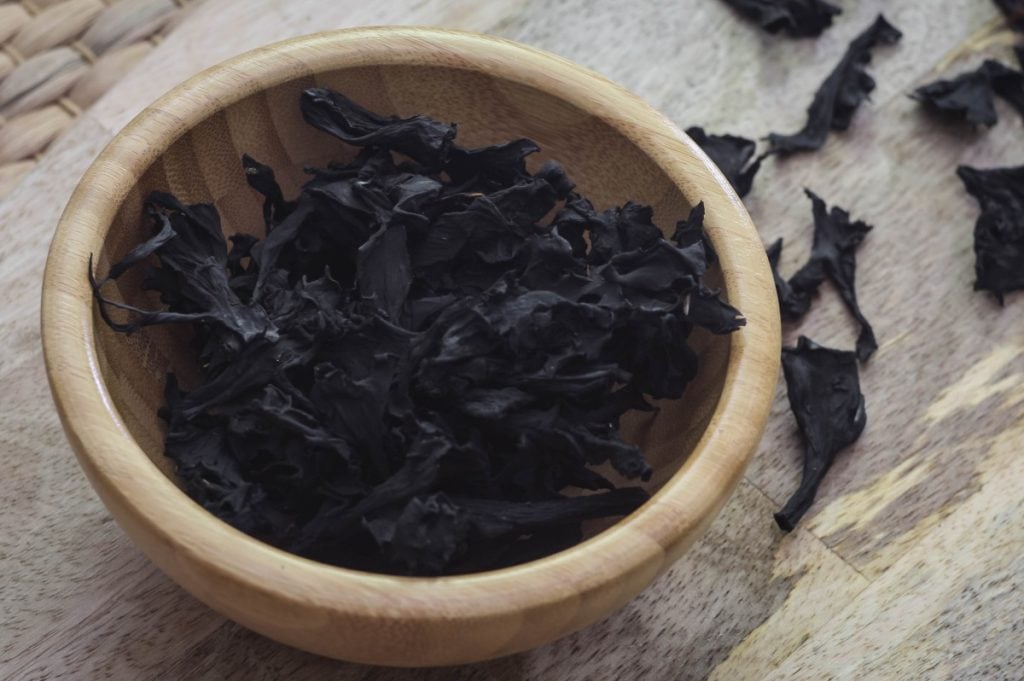
How To Clean Black Trumpet Mushrooms
Cleaning black trumpet mushrooms can be tricky. However, these wild mushrooms need to be cleaned before eating or they can have a gritty texture.
Not only are they quite brittle, but since they’re hollow they tend to accumulate a lot of debris and dirt inside of them.
You can reduce the amount of debris you’ll have to clean by not picking trumpets in areas with pine trees or after a heavy rainfall.
Cleaning your black trumpet mushrooms starts right at the moment of harvest.
Bring a pair of scissors along with you and snip off the dirt-covered bottoms before adding them to your basket or bag.
Most tools are too rough for cleaning off large pieces of debris and will rip your fragile mushrooms to pieces.
You can gently wipe or pick large pieces of debris off with your hands. We’ve also found that a silicone pastry brush is gentle enough for the job.
For particularly dirty trumpets, you can slice them lengthwise in half. Then gently dip them in some cold water. Try to be quick so they don’t absorb excess liquid.
After you wash them, set them on a cloth towel to air dry and release some extra moisture. Then you can either cook or start the preservation process as usual.
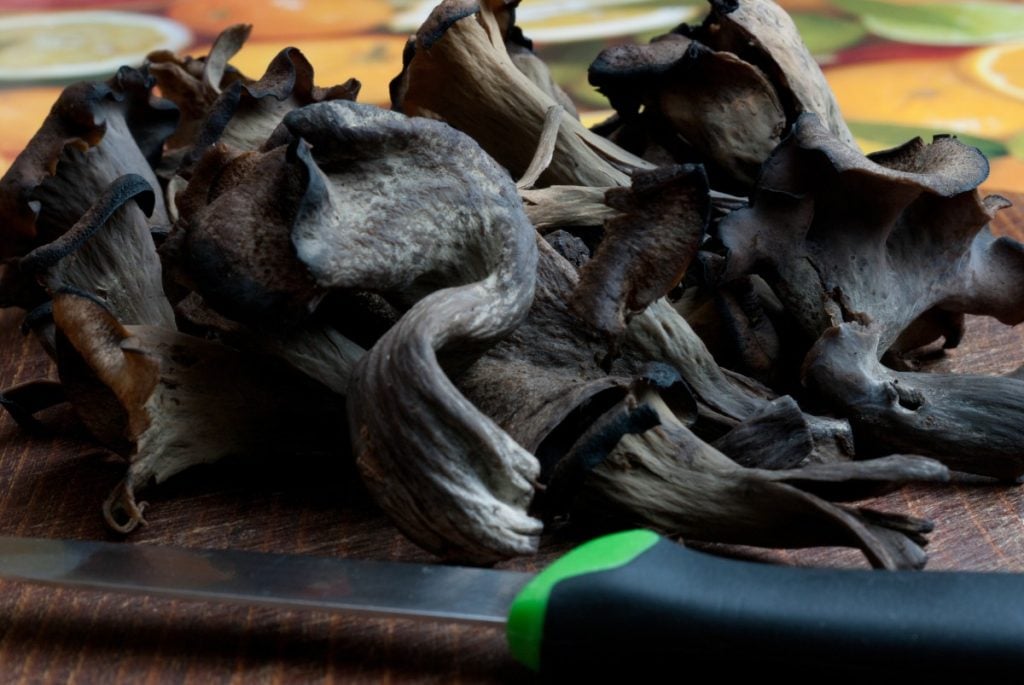
How To Cook Black Trumpet Mushrooms
Since black trumpet mushrooms are hollow, they cook very quickly.
Be careful not to overcook them. They usually only need a minute or two in the pan and they’re done.
You can cook black trumpet mushrooms the same way as any other mushroom and they’ll taste okay. But in our opinion, you’d be missing out on the best ways to enjoy them.
A good black trumpet mushroom recipe will ensure you get to experience all that they have to offer.
Their rich flavor makes them a great addition to a versatile range of recipes.
You can try them in pasta dishes, seafood recipes, soups, sauces, rice, salads, or paired with any kind of meat. You also can’t go wrong pairing them with cream.
Try to avoid particularly strong seasonings and spices that may overshadow their flavor.
Black Trumpet Mushroom Recipes
Here are links to a few of our favorite black trumpet mushroom recipes that we’ve found online:
Black trumpet mushroom risotto – via Nordic Forest Foods
Black trumpet mushroom pasta – via Tyrant Farms
Beluga lentils With black trumpets and mirepoix – via ForagerChef
Black trumpet mushroom sauce with cream and fresh tarragon – via Braised and Glazed
These are just a few ideas to get you started.
Once you start cooking with black trumpet mushrooms, we’re sure you’ll want to start experimenting with them in all sorts of different recipes!
If you’re a vegan, you can substitute black truffle mushrooms into our 25 Of The Best Vegan Mushroom Recipes.
Where Can You Get Black Trumpet Mushrooms?
Black trumpet mushroom price can be pretty hefty, especially if you’re buying a lot.
We’ve commonly seen them sold for around $25 (around £19) per lb. That’s about $55 or around £42 per kilogram.
You can save yourself money by trying to locate and harvest them in the wild. Although you need to know what you’re looking for and you may spend a lot of time without finding them.
It’s rare to find them sold fresh, except rarely at farmer’s markets.
You’ll most likely need to buy dried black trumpet mushrooms online. Sometimes you might be able to find them in specialty shops, but they aren’t found in your average grocery store.

Black Trumpet Mushroom Buying Guide
Since they’re so expensive, it’s important to know how to identify good, fresh black trumpet mushrooms to make sure you’re getting your money’s worth.
Make sure they’re firm and dry, and holding their characteristic trumpet shape.
Soggy mushrooms are a sign that you’re looking at a product which has been previously frozen.
Wild mushrooms aren’t like farmed mushrooms, so a bit of dirt or even live insects inside aren’t cause for concern. This is actually a good indicator that they’re freshly picked.
As with any mushroom, they should have a strong earthy smell. Don’t buy black trumpets with offputting smells. If they smell sour, they’re likely starting to rot.
See our article How to Tell if Mushrooms are Bad: The Telltale Signs for a more thorough investigation.
Can You Grow Black Trumpet Mushrooms Yourself?
Black trumpet mushrooms are very difficult to grow and cultivate commercially.
Unless you’re an experienced mushroom grower, we don’t recommend it, as it will likely only lead to frustration and disappointment.
If you do try to grow them, buy spores or cultures online from a reputable seller. Be sure to exactly follow instructions on the package in order to get the best results.
Different black trumpet strains may require different temperatures or fruiting conditions. So there’s no one-size-fits-all solution.
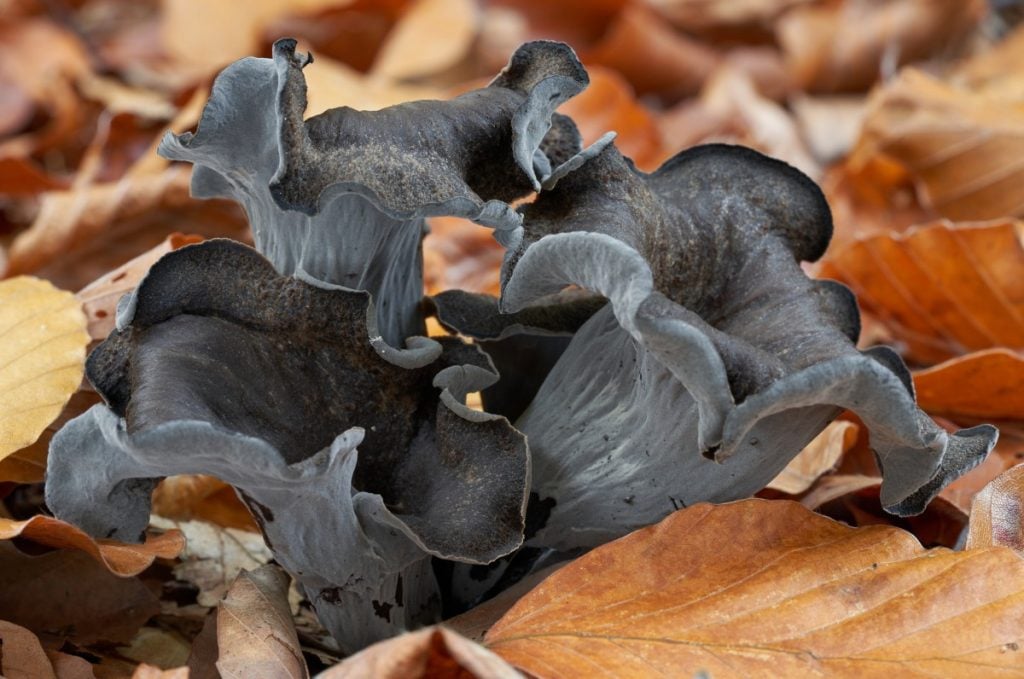
Final Thoughts
Black trumpet mushrooms are a delicious wild variety.
If you’re a mushroom lover, you need to give them a try at least once in your life. If nothing else, to see how they compare to other famous types like morels, porcini and chanterelles.
Due to their color and shape, it’s hard to find black truffles in the wild. Looking in mossy areas and following the other tips we’ve discussed in this article will maximize your chances.
Branch out and try some new types of mushrooms. Our article 20 Popular Types Of Mushrooms (And Their Uses) is a great resource to find even more great varieties.
